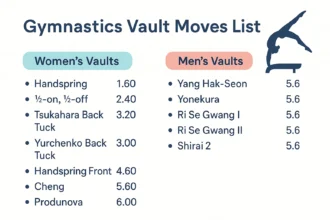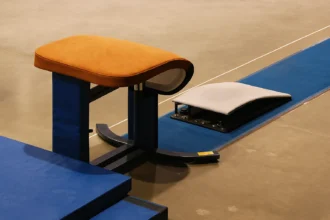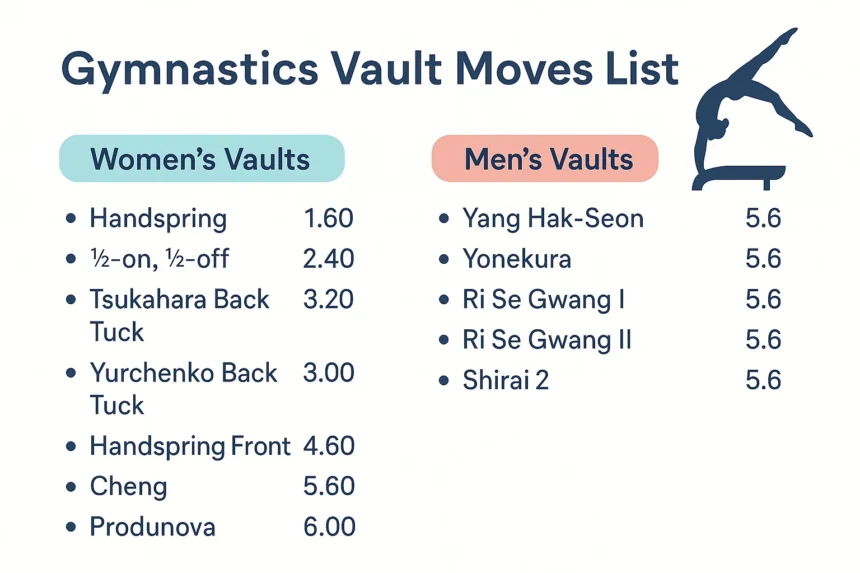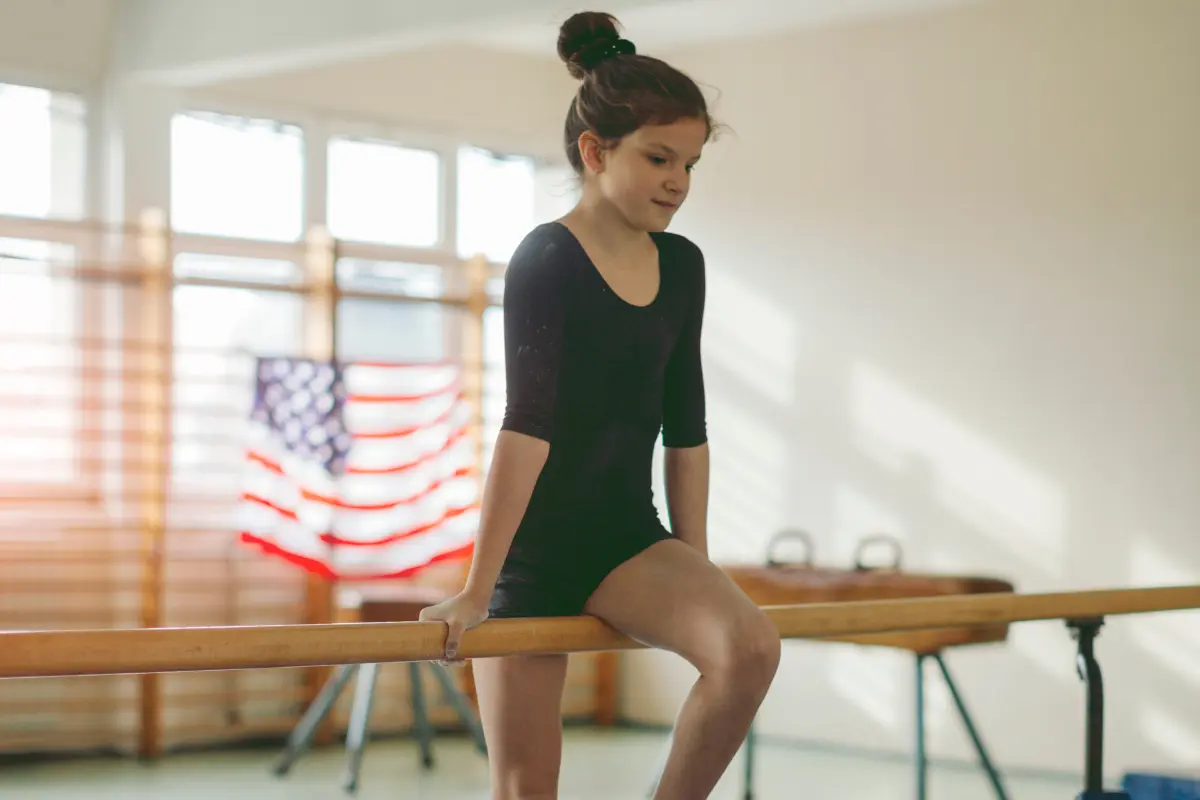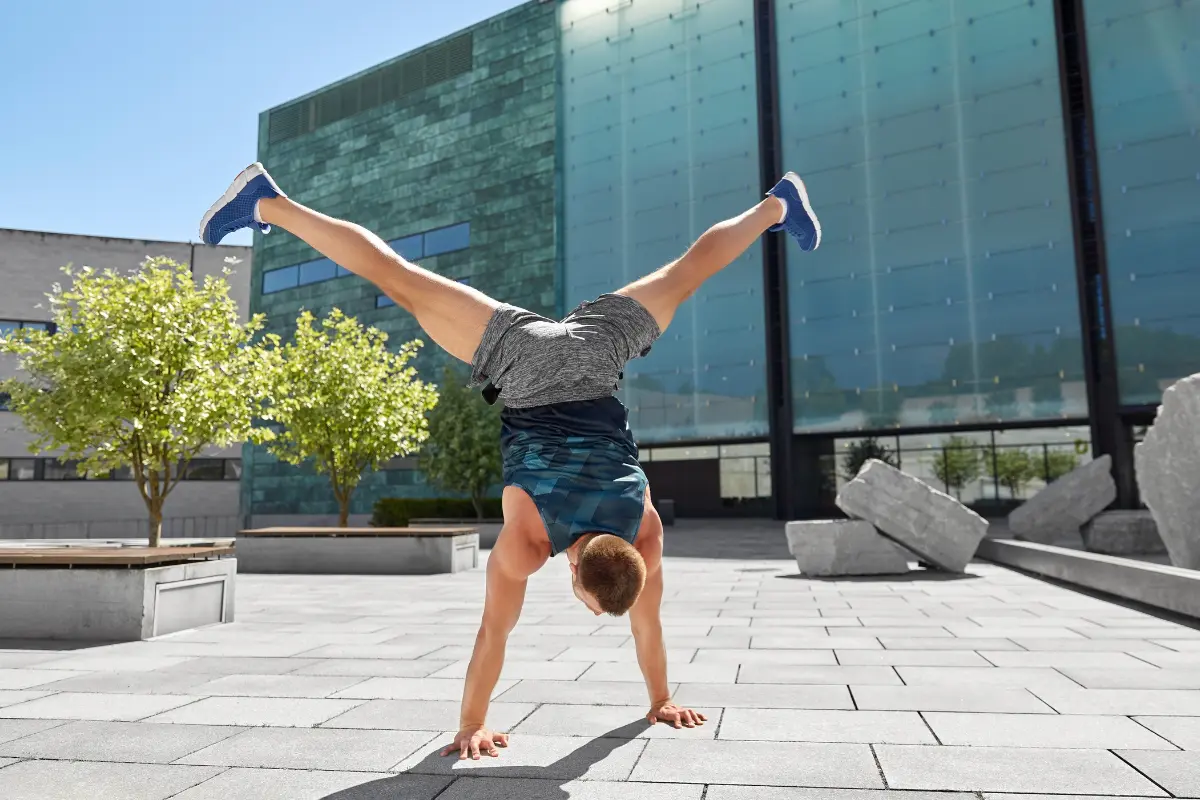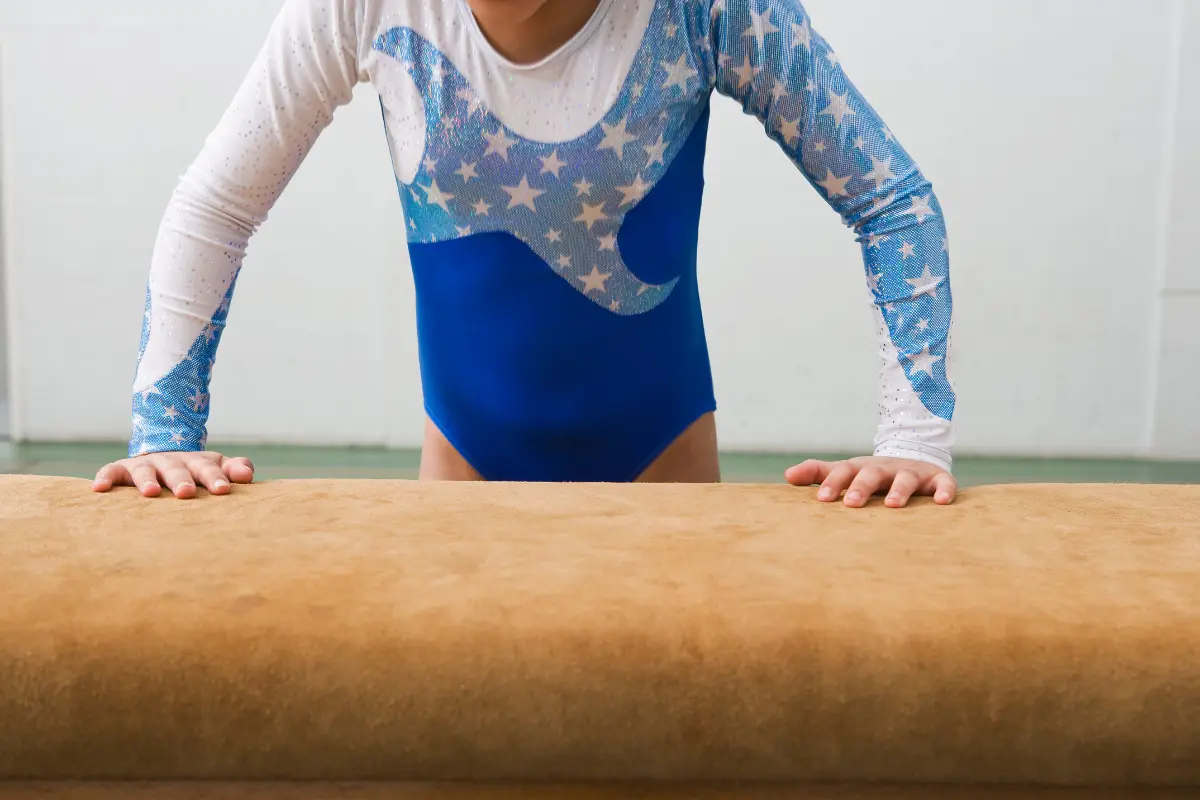In artistic gymnastics, the vault is a quick, high-intensity event performed on a specially designed vault table. The gymnast uses a 25-meter runway to gain momentum, hits a springboard, makes contact with the vault table, and then executes a skill (or combination of skills) before landing on the landing mat.
A good vault is over in about one second, but that one second can change everything in a competition.
- Vault has the biggest scoring range in gymnastics.
A basic handspring straight starts at 1.60.
Simone Biles’s Yurchenko double pike is worth 6.40. - That’s nearly five extra points just from upgrading the vault.
- No other event gives gymnasts such a big reward for doing a harder skill.
In team finals, only the top three scores count—so a strong vault can seriously boost the team total.
That’s why every national gymnastics program teaches vault step by step, starting with simple handsprings and building up to the amazing double flips and twists seen at the Olympics.
How FIG Vault Groups Work
In gymnastics, every vault is placed into one of five FIG groups based on two things:
- How the gymnast enters the vault table
- What kind of flip or twist they perform after
These groups help judges identify the correct flight path, assign the base Difficulty Score (D-score), and compare similar vaults fairly.
FIG Vault Groups in Women’s Artistic Gymnastics (WAG)
| WAG Group | Typical Entry & Flight Style | Beginner D-scores (2025–2028) |
|---|---|---|
| Group I | Straight handspring or ½-on, backward salto off | 1.6 – 3.6 |
| Group II | Handspring entry, forward salto off | 3.6 – 4.6 |
| Group III | ¼-turn onto the table, back salto with twist | 3.2 – 4.6 |
| Group IV | Round-off onto board, back handspring onto table, back salto | 3.0 – 4.4 |
| Group V | Round-off + ½-on, forward salto off (e.g. Cheng) | 3.8 – 4.8 |
What Do These Groups Do?
Vault groups help judges know what kind of movement to expect. Each group follows a specific entry style and flip direction, so it gives judges a clear standard for how the vault should look.
These groups also determine the vault’s base D-score. Harder vaults with more twists or flips are placed in higher-value groups.
In major competitions like the Olympics, gymnasts must perform two vaults from different groups to qualify for vault finals—this rule ensures variety and well-rounded ability.
What About Men’s Vault?
Men follow the same group logic and physics, but with a few key differences:
- The vault table is 135 cm high, 10 cm taller than in women’s gymnastics.
- Under the 2025–2028 FIG Code, every vault in MAG lost 0.4 in D-score.
- As a result, the hardest men’s vaults now top out at 5.6.
Building Blocks: The Universal Technique
Every vault follows the same five technical phases. Mastering these phases creates the foundation for clean, powerful vaulting:
1. Approach & Hurdle
The vault begins with a sprint down the runway. But speed only converts to height if the final two steps are quick, low, and explosive. A fast, controlled hurdle helps set up a strong takeoff from the springboard.
2. Pre-flight
This is the moment between leaving the springboard and contacting the vault table. A straight line through the shoulders and hips helps maintain momentum. If alignment breaks here, it can ruin the vault before it even reaches the table.
3. Block
As the hands hit the table, the gymnast performs a quick shoulder shrug and wrist extension—this is the “block.” It acts like a rebound, launching the gymnast upward and giving them time to twist or flip.
4. Post-flight
This is where the salto and twist happen. A strong block creates enough airtime for clean rotation. A weak block cuts airtime short and often leads to rushed or incomplete landings.
5. Landing
Gymnasts should land with their feet together, hips over heels, and soft, bent knees. Judges deduct for steps, hops, or low chest positions.
Starter Vaults: Where Every Gymnast Begins
These foundational vaults teach the basics of blocking, flight, and landing. They build confidence, shape proper technique, and set the stage for more advanced skills.
| Vault Name | FIG Group | D-score (WAG) | Why It’s a Starting Point |
|---|---|---|---|
| Handspring | Group I – Handspring | 1.60 | Teaches clean posture, heel drive, and basic block technique. |
| ½-on, ½-off (Quarter Twist) | Group I – Handspring | 2.40 | Introduces simple twisting without changing salto direction. |
| Tsukahara Tuck | Group III – Tsuk/Kasamatsu | 3.20 | Adds a blind quarter-turn entry and a back tuck, using familiar block mechanics. |
| Yurchenko Back Tuck | Group IV – Yurchenko | 3.00 | Combines a round-off and back handspring entry with a back tuck off the table. |
Mid-Level Upgrades: Adding Layouts and Single Twists
Once a gymnast can maintain a stretched (layout) body line without bending or piking down, they begin layering in twists—usually in half-turn increments. These vaults mark the transition from foundation to competition-ready skills.
| Vault Name | FIG Group | D-score (WAG) | Why It Matters |
|---|---|---|---|
| Handspring Front Pike ½ (Phelps) | Group II – Front Salto | 4.00 | Introduces blind landings while maintaining a forward rotation. |
| Handspring Front Layout ½ | Group II – Front Salto | 4.60 | Adds twist in a stretched body, prepping for harder layouts. |
| Tsukahara Layout 1/1 (Tsuk Full) | Group III – Tsuk/Kasamatsu | 4.40 | Builds full twist timing on a ¼-on entry. |
| Yurchenko Layout 1½ (DTY) | Group IV – Yurchenko | 4.80 | A staple elite vault offering high scoring potential with solid control. |
| RO ½-on Front Layout ½ | Group V – RO ½-on (Cuervo) | 4.80 | Offers strong difficulty without extreme rotation; part of the Cheng family. |
The “Big” Vaults: High-Risk, Podium-Changing Skills
These elite vaults offer huge scoring rewards—but only if executed with strength, control, and flawless timing. They’re often seen in Olympic finals and World Championship podium battles.
| Vault Name | FIG Group | D-score (WAG) | What Makes It Elite |
|---|---|---|---|
| Biles I – Yurchenko Double Pike | Group IV – Yurchenko | 6.40 | The highest-valued WAG vault: two tight pike saltos off a massive block. |
| Produnova – Handspring Double Front Tuck | Group II – Front Salto | 6.00 | Two forward saltos with a blind landing. Extreme risk, extreme reward. |
| Front Layout 2/1 | Group II – Front Salto | 5.80 | Popular in NCAA for its height and flair, with a forward landing. |
| Cheng – RO ½-on, Layout 1½ Twist | Group V – RO ½-on (Cuervo) | 5.60 | Combines Yurchenko speed with forward twisting complexity. |
| Tsukahara Layout 2½ Twist | Group III – Tsuk/Kasamatsu | 5.60 | Difficult twisting off a ¼-on entry; rarely performed due to high air control demands. |
| Front Layout 1½ Twist | Group II – Front Salto | 5.40 | A strong front-twisting layout with less risk than double flips. |
| Amanar – Yurchenko Layout 2½ Twist | Group IV – Yurchenko | 5.40 | Former Olympic favorite; fast, powerful, and consistent in elite competition. |
| RO ½-on, Front Layout 1½ Twist | Group V – RO ½-on (Cuervo) | 5.60 | Cheng-style vault with solid D-score and forward rotation. |
Source: static.usagym.org
What These Vaults Have in Common:
- All score 5.40 or higher, with the Biles I leading at 6.40
- Demand exceptional power, precision, and air control
- Frequently seen in vault finals and international podium battles
Men’s Power Vaults: Where 5.6 Still Hurts
Women’s vault scores often make the headlines, but men’s vault is just as intense—filled with huge flips, twisting landings, and a lot of force on the body.
After the 2025 scoring update, all of the hardest men’s vaults are now worth 5.6 D-score, even though they’re incredibly difficult and risky. Here are five of the toughest:
- Yang Hak-Seon – Handspring layout with triple twist
- Yonekura – Tsukahara double pike with 2½ twists
- Ri Se Gwang I & II – Handspring double front pike, with or without ½ twist
- Shirai 2 – Yurchenko with 3½ twists
This scoring change was made to slow down the push for harder and riskier vaults. Too many gymnasts were getting injured—especially during the Paris 2024 cycle—so judges now reward cleaner execution over pure difficulty.
Even though they’re all capped at 5.6, these vaults are still some of the most powerful and dangerous skills in the sport.
Source: zhoxxyy.com
Safety Progression: Why Basics Still Matter
Even the best gymnasts in the world—including Simone Biles—build every new vault on a solid technical foundation. No matter how advanced the skill, the basics still matter.
- Consistent Straight-Body Block – A bent-arm block may “work” for a tuck, but it stalls a double pike.
- Rebound Landing Drills – Sticking without deep squat not only saves 0.1–0.3 in deductions, it protects knees.
- Incremental Twist Loads – Coaches often teach ½-twist hops on tramp first, then full turns on a soft pit, before risking the board.
Vault progression is all about learning to add flips and twists without losing control or form. The 2025–2028 Code rewards clean gymnastics—high D-scores help, but they won’t hide bent knees or deep landings.
If you run strong, block like a pogo stick, and treat every new skill as a layer on a solid base, the basics turn into big vaults. And big vaults—done well—can win medals.


